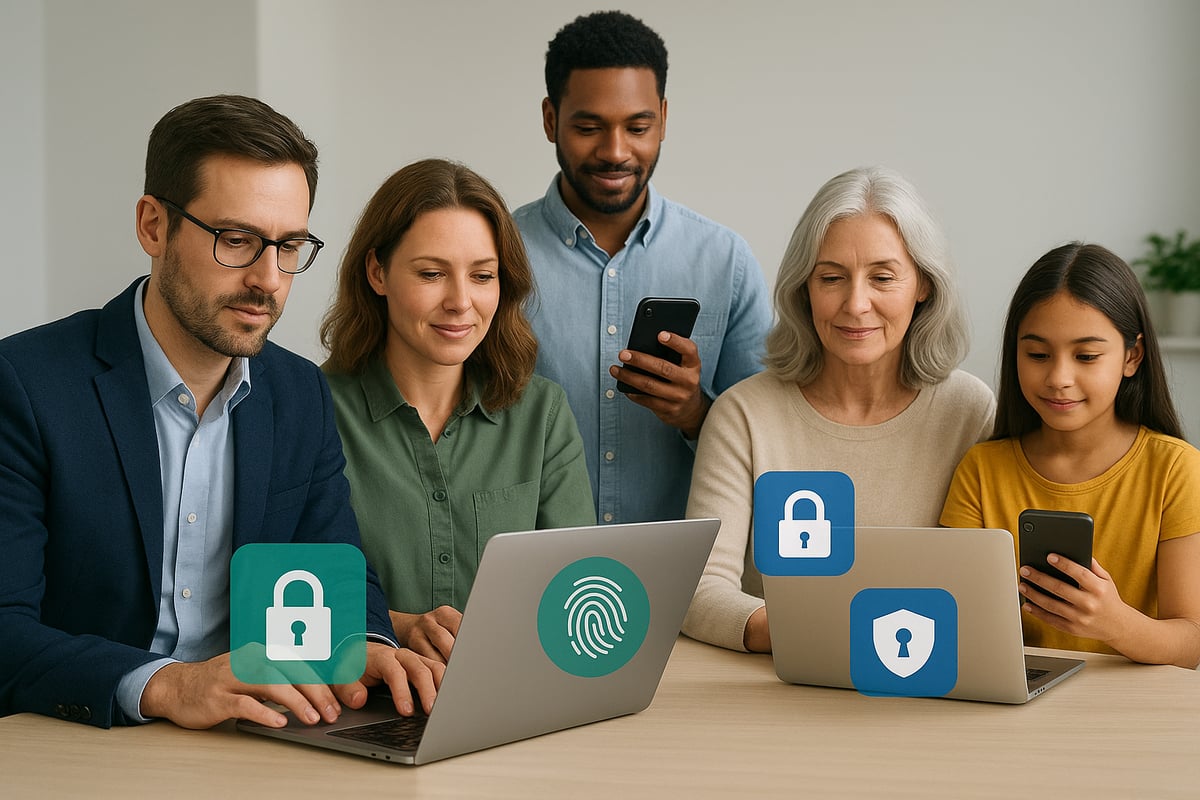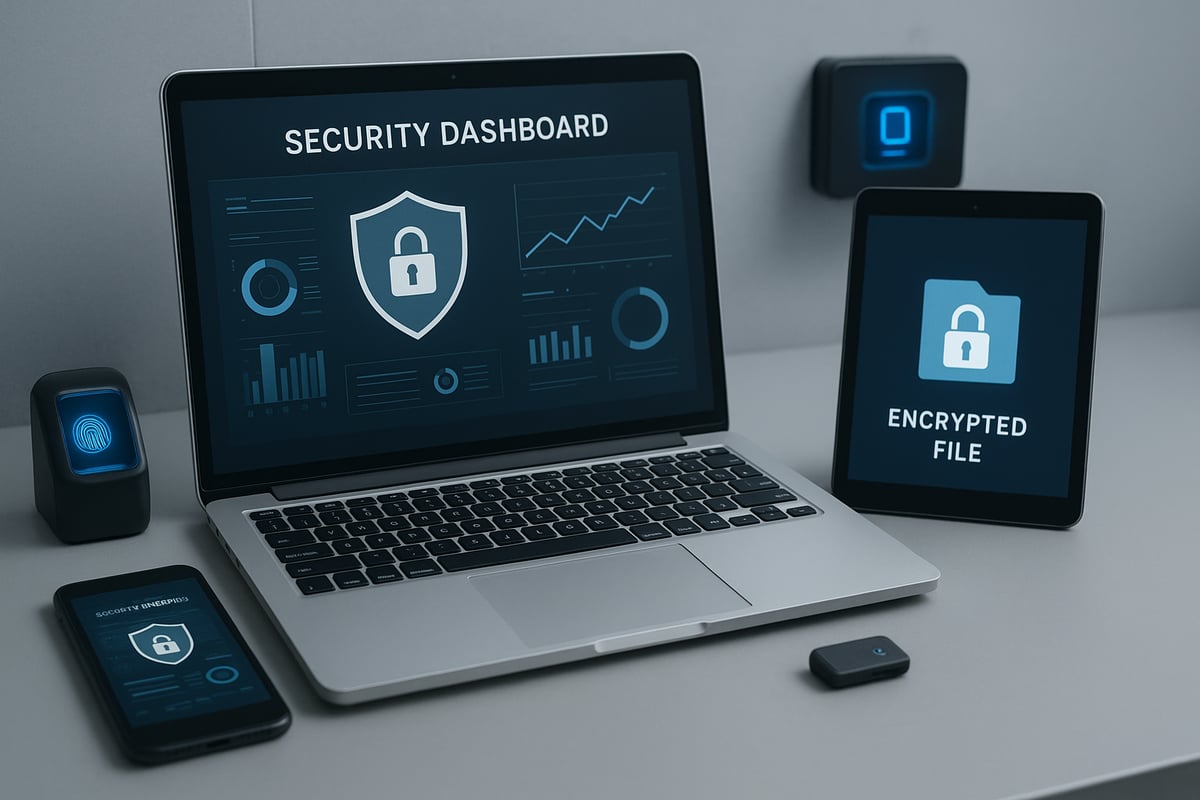The Essential Guide to Private and Secure Practices (2025)
In an era where every click is tracked and data breaches make headlines, protecting your privacy is no longer a choice, it is a necessity. The risks of personal data exposure, cyber threats, and widespread surveillance are only increasing as we move into 2025.
By adopting private and secure habits, you can shield your information, safeguard your identity, and maintain control over your digital presence. This guide will provide you with actionable strategies, expert insights, and step-by-step solutions designed for the challenges of today and tomorrow.
Prepare to empower yourself with the latest secure practices to ensure your peace of mind in a rapidly evolving digital world.
Understanding Privacy and Security in 2025
The landscape of privacy and security is changing rapidly as we move into 2025. With new technologies and threats emerging, understanding the core elements of a digital life is crucial for everyone.

Evolving Threat Landscape
Cyberattacks have grown more sophisticated, targeting not just organizations but individuals as well. Hackers now use AI and automation to craft highly convincing phishing emails, launch ransomware attacks, and even create deepfake content.
In 2024, there was a 35 percent increase in personal data breaches, exposing millions to identity theft and financial fraud. According to 2024 data breaches statistics, the number of breaches and impacted records reached record highs, highlighting the urgent need for private and secure habits.
Attackers exploit any weakness, so proactive defense is more important than ever.
Regulatory Changes and Legal Landscape
New privacy laws are reshaping how data is collected, stored, and shared. Updates to GDPR, new US state regulations, and global standards all demand stronger user consent and transparency.
Organizations face steep fines if they mishandle data or fail to comply with these rules. For individuals, the legal landscape means more rights and responsibilities around private and secure information management. Understanding these changes helps you stay compliant and protected.
The Importance of Digital Hygiene
Good digital hygiene is foundational to a private and secure life. This means regularly updating software and devices to patch vulnerabilities, using strong passwords, and enabling multi-factor authentication.
Awareness programs and ongoing user education ensure everyone understands potential risks. Practicing digital hygiene reduces the chance of falling victim to common attacks and keeps your data safer.
Common Vulnerabilities
Many threats exploit everyday oversights. Outdated devices and software are easy targets for attackers. Weak or reused passwords open doors to account takeovers.
Unsecured Wi-Fi networks can expose private and secure data to interception. Social engineering tricks, like impersonation or urgent requests, remain highly effective. Addressing these weaknesses is essential for robust protection.
The Role of Personal Responsibility
Personal actions have a major impact on privacy. Oversharing on social media or granting excessive app permissions can compromise private and secure information.
Balancing convenience with security is key. For example, a high-profile data leak in 2024 occurred when an individual reused passwords across accounts, allowing attackers broad access after a breach. Vigilance and smart habits make a difference.
Future Trends in Privacy and Security
Looking ahead, privacy-enhancing technologies (PETs) are gaining traction. Decentralized identity solutions are emerging, giving users more control over their digital presence.
There is growing demand for zero-knowledge platforms and end-to-end encryption, enabling private and secure communications. Staying informed about these trends will help you adapt as threats and solutions evolve.
Core Principles of Private and Secure Practices
Practicing core principles is essential for anyone aiming to maintain a private and secure digital life. These principles form the foundation for protecting your identity, data, and peace of mind in a fast-evolving threat landscape.

Data Minimization and Control
A private and secure approach starts with minimizing the data you share. Only provide information that is absolutely necessary, both online and offline. Adjust privacy settings on your social media accounts and devices to restrict access to your personal details.
For instance, limit app permissions so they only access your contacts or location when required. This proactive stance reduces your exposure to data breaches and identity theft. Remember, the less data you share, the easier it is to stay private and secure in your daily life.
Encryption: The Backbone of Security
Encryption is at the heart of every private and secure system. There are several types, including end-to-end, at-rest, and in-transit encryption. These methods ensure that your messages, files, and backups remain protected from unauthorized access.
Popular messaging apps now offer default end-to-end encryption, making conversations confidential by design. For sensitive files, always use encrypted storage solutions. This extra layer of security is fundamental to maintaining a truly private and secure environment.
Authentication and Access Management
Robust authentication is a key pillar of secure practices. Multi-factor authentication (MFA) and biometric logins, such as fingerprint or facial recognition, add critical layers of defense. Password managers help generate and store complex, unique passwords for each account.
Embrace passkey adoption for a streamlined yet secure login process. For shared devices and accounts, implement role-based access controls to ensure only authorized users can view or modify sensitive information. These steps are crucial to keep your digital spaces private and secure.
Secure Communication Channels
Using secure communication channels is vital for a private and secure lifestyle. Opt for VPNs to mask your online activity and use encrypted email and messaging services for sensitive conversations. This helps shield your data from interception, especially on public Wi-Fi networks.
Avoid using unsecured networks for any transaction involving personal or financial information. For example, data sent over an open network can be easily captured by cybercriminals. Prioritizing secure channels is a core element of private and secure practices.
Physical Security Measures
Physical security is often overlooked but remains an essential component of private and secure living. Store paper documents in locked safes or vaults and shred sensitive paperwork before disposal. Invest in physical locks and access controls on your devices.
Consider implementing security cameras and alarms for added protection at home or in the office. These tangible steps help ensure that both your digital and physical assets remain private and secure at all times.
Ongoing Education and Awareness
The landscape of private and secure practices is always changing. Stay updated on new threats and best practices by participating in regular cybersecurity training and awareness programs. Encourage your family or team to join annual security reviews and workshops.
For professionals, keeping up with the latest IAB Tech Lab's 2025 privacy framework updates is critical to understanding evolving standards. Ongoing education empowers you to maintain a private and secure environment, no matter how the digital world changes.
Step-by-Step Guide to Implementing Private and Secure Practices
Implementing private and secure practices is essential for every individual, family, and business in 2025. This guide walks you through clear, practical steps to protect your data, identity, and peace of mind. By following these recommendations, you can minimize your digital risks and build a stronger security posture.

Step 1: Assess Your Current Privacy and Security Posture
Begin with a thorough assessment of your current private and secure environment. Conduct a security audit to identify which devices, accounts, and data are most critical to your daily life or business operations.
Use checklists and online assessment tools to uncover weaknesses. Look for issues like reused passwords, outdated devices, or software lacking recent updates.
A careful review often reveals overlooked vulnerabilities. For example, many people discover they are still using weak or duplicate passwords, putting their private and secure information at risk.
Step 2: Strengthen Digital Defenses
Once you know your vulnerabilities, focus on strengthening your digital defenses. Regularly update your operating systems, applications, and firmware to patch security holes.
Enable firewalls and antivirus tools on all devices. Set them to update automatically for continuous protection. According to the FBI's 2024 Internet Crime Report, cybercrime losses reached record highs, making these steps vital.
By making your digital environment private and secure, you reduce your risk of malware infections and unauthorized access.
Step 3: Enhance Authentication and Access Controls
Effective authentication is a cornerstone of private and secure practices. Activate multi-factor authentication (MFA) on all accounts, combining passwords with biometrics or verification codes.
Use a password manager to generate and store strong, unique passwords for every account. Periodically review account permissions and remove access for unused or unnecessary users.
This approach protects your private and secure assets from unauthorized entry, especially after a data breach.
Step 4: Protect Sensitive Data
Safeguarding sensitive information is a key element of a private and secure digital life. Encrypt important files and backups, both on devices and in the cloud.
Store critical documents in secure digital vaults. Choose cloud providers with zero-knowledge architecture, ensuring only you control access.
Never keep unencrypted sensitive data on your devices. This habit keeps your private and secure information safe if your device is lost or stolen.
Step 5: Secure Communication and Browsing
To keep your communications private and secure, use encrypted messaging and email platforms. When accessing sensitive information online, always connect through a VPN, especially on public Wi-Fi.
Regularly clear your cookies and browser history to prevent tracking and unwanted data harvesting.
These measures help maintain a private and secure online presence and reduce your risk of interception or surveillance.
Step 6: Safeguard Physical Assets
Physical security is just as important as digital. Store paper documents in locked safes or vaults, and use security cameras and alarms for your home or office.
Dispose of sensitive materials by shredding or professional destruction. These steps help keep your private and secure information out of the wrong hands.
For example, identity theft often starts with discarded paperwork, making physical safeguards essential.
Step 7: Continuously Monitor and Improve
Private and secure practices are not one-time tasks. Set up alerts for suspicious activity across your accounts and devices.
Schedule regular security reviews to update passwords, software, and settings. Stay informed about emerging cyber threats and adapt your defenses accordingly.
Continuous improvement ensures your private and secure strategy evolves to meet new challenges, like AI-driven phishing attacks.
The Role of Secure Digital Vaults for Families and Individuals
Digital vaults have become crucial for families and individuals aiming to remain private and secure. They provide encrypted storage for vital documents such as wills and health directives.
With customizable access and delivery rules, only trusted people can retrieve your information when needed. Integrated emergency planning tools further enhance readiness.
For example, during a crisis, families instantly access important documents, ensuring continuity and protection. Solutions like IronClad Family offer patented, zero-knowledge vaults for comprehensive digital and physical security.
Advanced Tools and Technologies for Privacy and Security
Staying private and secure in 2025 requires more than just awareness—it demands the right tools and technologies. As threats become more sophisticated, leveraging advanced solutions is critical for protecting your data, identity, and peace of mind. Here is a focused look at the latest innovations designed to keep your digital life private and secure.

Privacy-Enhancing Technologies (PETs)
Privacy-enhancing technologies, or PETs, are essential for anyone committed to a private and secure lifestyle. These tools use methods like encryption, anonymization, and differential privacy to shield your data from prying eyes.
For example, encryption scrambles information so only authorized users can read it. Anonymization removes personal details from datasets, while differential privacy adds "noise" to prevent identification. The Tor browser is a popular PET, allowing users to browse anonymously by routing traffic through multiple nodes.
By integrating PETs, you gain stronger control over your private and secure communications, transactions, and daily digital interactions.
Next-Generation Authentication
Authentication methods have evolved rapidly, supporting more private and secure access to your accounts and devices. Passkeys and biometric authentication, like fingerprint or facial recognition, are replacing traditional passwords for many users.
Hardware security keys, such as YubiKey or Titan, offer a physical layer of protection by requiring a device to access sensitive accounts. The shift toward passwordless authentication is accelerating, with adoption rates expected to rise significantly in 2025.
Relying on next-generation authentication ensures your digital identity remains private and secure, even if passwords are compromised.
Secure File Storage and Sharing
Storing and sharing files in a private and secure manner is vital for both individuals and organizations. Encrypted cloud storage solutions, like those offering zero-knowledge architecture, ensure that only you can access your data.
When transferring files, opt for tools that provide end-to-end encryption. For example, legal professionals often use secure file sharing platforms to send confidential documents, protecting them from interception.
By adopting these technologies, your sensitive files remain private and secure, whether at rest or in transit.
Advanced Threat Detection and Response
Modern threats demand advanced detection and response capabilities to stay private and secure. AI-powered security tools can analyze user behavior, detect anomalies, and provide real-time alerts about suspicious activity.
Automated incident response systems help organizations quickly contain and mitigate threats. For instance, machine learning can identify phishing attempts before they reach your inbox, reducing the risk of data breaches.
Implementing these solutions enables you to react swiftly, keeping your environment private and secure against emerging cyberattacks.
Privacy-Focused Browsers and Search Engines
Choosing the right browser and search engine is crucial for maintaining a private and secure online experience. Privacy-focused browsers, such as Brave, Firefox, and Tor, reduce tracking and block unwanted scripts. Search engines like DuckDuckGo and Startpage avoid profiling users and do not store search histories.
|
Browser |
Key Feature |
Search Engine |
Key Feature |
|---|---|---|---|
|
Brave |
Built-in ad blocker |
DuckDuckGo |
No tracking, no profiling |
|
Firefox |
Enhanced privacy |
Startpage |
Anonymous search results |
|
Tor |
Anonymity network |
- |
- |
Using these platforms helps ensure your browsing habits and search queries remain private and secure.
Emerging Technologies on the Horizon
Future-focused solutions are reshaping how we stay private and secure. Decentralized identity management allows users to control personal information without relying on central authorities. Blockchain technology is being used for secure recordkeeping, making tampering nearly impossible.
Quantum-resistant encryption is also in development, preparing for the next wave of computing power. Adopting these emerging tools ensures your private and secure practices remain effective as technology evolves.
Best Practices for Individuals, Families, and Organizations
Staying private and secure in 2025 requires more than just technical know-how. It is about fostering smart daily habits, building a culture of awareness, and adapting to ongoing changes. Below, we break down essential practices for individuals, families, and organizations. Use these strategies to help ensure your information, identity, and assets remain protected in a world where privacy is increasingly valuable.
Individual Privacy and Security Habits
Personal vigilance is the cornerstone of a private and secure lifestyle. Start by limiting what you share on social media. Avoid posting real-time locations or sensitive personal details that could be used for identity theft. Regularly review and adjust app permissions to restrict unnecessary access to contacts, photos, or location data.
It is essential to practice safe online shopping and banking. Only use trusted websites with secure connections (HTTPS) and never share financial information over unsecured channels. Be cautious with emails or texts that request personal information, as phishing scams are becoming more sophisticated each year.
Consider using a password manager to generate and store unique passwords for each account. Multi-factor authentication adds another layer of defense, making it harder for unauthorized users to gain access. By adopting these private and secure habits, you significantly lower your risk of data breaches and identity theft.
Family and Household Strategies
Families must work together to develop private and secure routines at home. Start by setting up shared digital vaults for storing important documents, such as birth certificates or insurance records. Teach children about online safety, including the importance of not sharing personal information with strangers and recognizing suspicious links or messages.
Emergency preparedness is another vital area. Maintain updated contact lists, medical information, and emergency plans in a secure, accessible location. Encourage family members to keep devices updated and use strong passwords.
Regularly discuss privacy settings on social networks and smart devices. Schedule family security check-ins to review digital habits, reinforce safe behaviors, and identify areas for improvement. Together, these steps create a private and secure home environment that protects everyone.
Small Business and Professional Solutions
For small businesses, adopting private and secure practices is both a necessity and a legal requirement. Start with comprehensive employee cybersecurity training programs that teach staff how to recognize threats, avoid phishing, and use secure file-sharing tools. Implement strong access controls and require multi-factor authentication for all critical systems.
Choose collaboration platforms that offer end-to-end encryption and audit trails. Stay current with regulations, as new privacy laws are emerging. For example, businesses should be aware of the Overview of 2025 U.S. state privacy laws, which detail upcoming requirements for data protection and user consent.
Regular compliance audits help identify gaps and reduce the risk of penalties. By prioritizing private and secure business operations, organizations can protect sensitive data, maintain customer trust, and avoid costly incidents.
Managing Digital Legacies and Estate Planning
Digital assets are now a critical part of estate planning. Start by creating a secure inventory of your online accounts, digital documents, and access credentials. Appoint a digital executor or trusted contact who can manage your assets if needed. Use encrypted storage or a digital vault to safeguard wills, health directives, and financial records.
Establish clear instructions for accessing and transferring digital assets. Choose delivery methods that ensure only authorized individuals receive sensitive information. This might include secure sharing tools or time-delayed access features.
Review and update your plans regularly as technology evolves. By taking these private and secure steps, you ensure your legacy is managed responsibly and your family can access what they need during critical moments.
Maintaining Privacy in a Connected World
The rise of smart home devices and wearables brings new challenges for staying private and secure. Begin by reviewing the privacy settings on all connected devices, from smart speakers to fitness trackers. Disable unnecessary features that collect or share personal data.
Keep device firmware up to date and replace unsupported hardware when possible. Use strong, unique passwords for each device and network. Segment your Wi-Fi networks, creating separate connections for guests and IoT devices to limit exposure.
Regularly audit data-sharing permissions across platforms and apps. Educate household members about the risks of connected devices. These steps help you maintain a private and secure environment, even as technology becomes more integrated into daily life.
Staying Ahead of Evolving Threats
Cyber threats are constantly evolving, so maintaining a private and secure posture means ongoing vigilance. Follow trustworthy cybersecurity news sources to stay informed about new risks and solutions. Participate in online privacy communities for peer support and knowledge sharing.
Adopt new tools and practices as they become available, such as quantum-resistant encryption for sensitive data. Schedule regular reviews of your security setup, updating passwords, software, and policies as needed.
Proactive adaptation is key. By embracing change and staying informed, you can ensure your private and secure practices remain effective, even as the threat landscape shifts.
As you’ve seen throughout this guide, prioritizing privacy and security is more than a best practice—it’s essential for protecting your family’s future in an unpredictable digital world. By organizing your critical documents, estate plans, and emergency instructions in a secure digital vault, you can ensure that your loved ones are always prepared, no matter what life brings. If you’re ready to take the next step toward true peace of mind, I encourage you to explore IronClad Family’s platform and see how easy it is to safeguard what matters most.
You can get started today with a quick 30-minute consultation to learn about privacy and security for you and your clients here.

Sahar Lester
Sahar Lester is the Founder and CEO of IronClad Family, a company dedicated to helping families and businesses safeguard their most valuable assets through secure digital vaults. With a master’s degree in Security Technologies from the University of Minnesota and experience spanning cybersecurity, leadership, and international commerce, Sahar bridges the gap between innovation and protection. She also serves as an adjunct professor at Metropolitan State University, mentoring the next generation of cybersecurity professionals.



